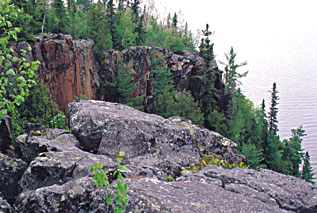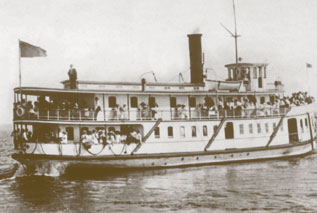 |
The Rocks of Ages
Lake Temiskaming, a widening of the Ottawa, has
its source approximately 240 km to the east in the
province of Quebec. The name ‘Temiskaming’
is an Algonkian word meaning ‘deep water.’
At Dawson’s Point, visible from Haileybury’s
shoreline, impressive limestone cliffs stand as
remnants of an ancient sea bed. These 410 to 500
million year-old rocks are of the Paleozoic era.
They form the lower part of the Lake Temiskaming
Rift Valley, a structural feature in which the younger
rocks are displaced some 235 to 300 m downwards
by massive faults into the Wabi River Valley. On
either side of the valley are Precambrian rocks
containing a wide variety of fossils.
During the Pleistocene era this entire area was
subjected to Wisconsin continental glaciation as
ice packs moved southward from Hudson Bay over most
of Canada and the northern USA. When the ice retreated
Lake Barlow formed in the Lake Temiskaming area
and seasonally varved – or layered –
clay and silt collected on the lake bottom. Subsequently,
when Lake Barlow drained some 8700 years ago, 20
to 45 cm of top soil formed on top of the clay creating
a fertile clay belt. |
| |
|
|
 |
Settlement and Conflagration
Charles Cobbold Farr, chief trader at the Hudson
Bay Company’s Fort Temiskaming, in 1883 purchased
30 acres of land known as Humphrey’s Depot.
Natives had originally named the site Matabanick
– place where the trail comes out –
in reference to the end of a portage from the upper
Montreal River to Lake Temiskaming.
Farr left the Hudson Bay Company in 1889 and settled
on this property which he called Haileybury. With
the arrival of the Temiskaming & Northern Ontario
Railway, and the subsequent discovery of silver
at Cobalt in 1903, Haileybury’s population
soared.
By 1910 Haileybury was a bustling community with
electric streetcar service, several large hotels,
majestic homes along Lakeshore Road known as Millionaire’s
Row and a National Hockey Association team –
the Haileybury Comets. In 1912 Haileybury became
the Judicial Seat for the newly created District
of Temiskaming. The Haileybury Court House and Land
Registry Office were built soon after.
On October 4, 1922 the Great Fire burned 650 square
miles destroying property and communities in 18
townships within the district. Within 3 to 6 hours,
90% of the Town of Haileybury was destroyed leaving
3500 people homeless and $2 000 000 in property
damages. |
| |
|
